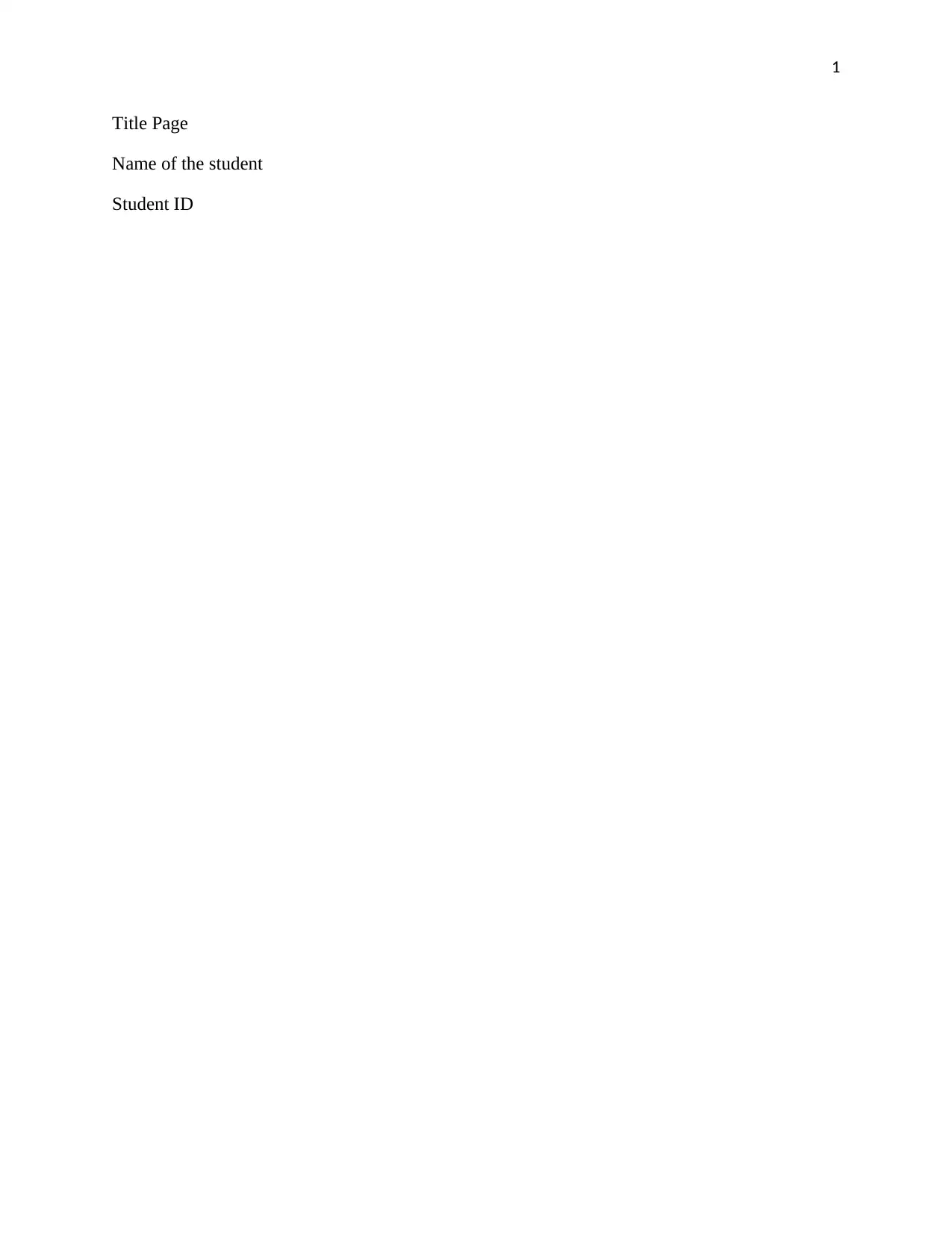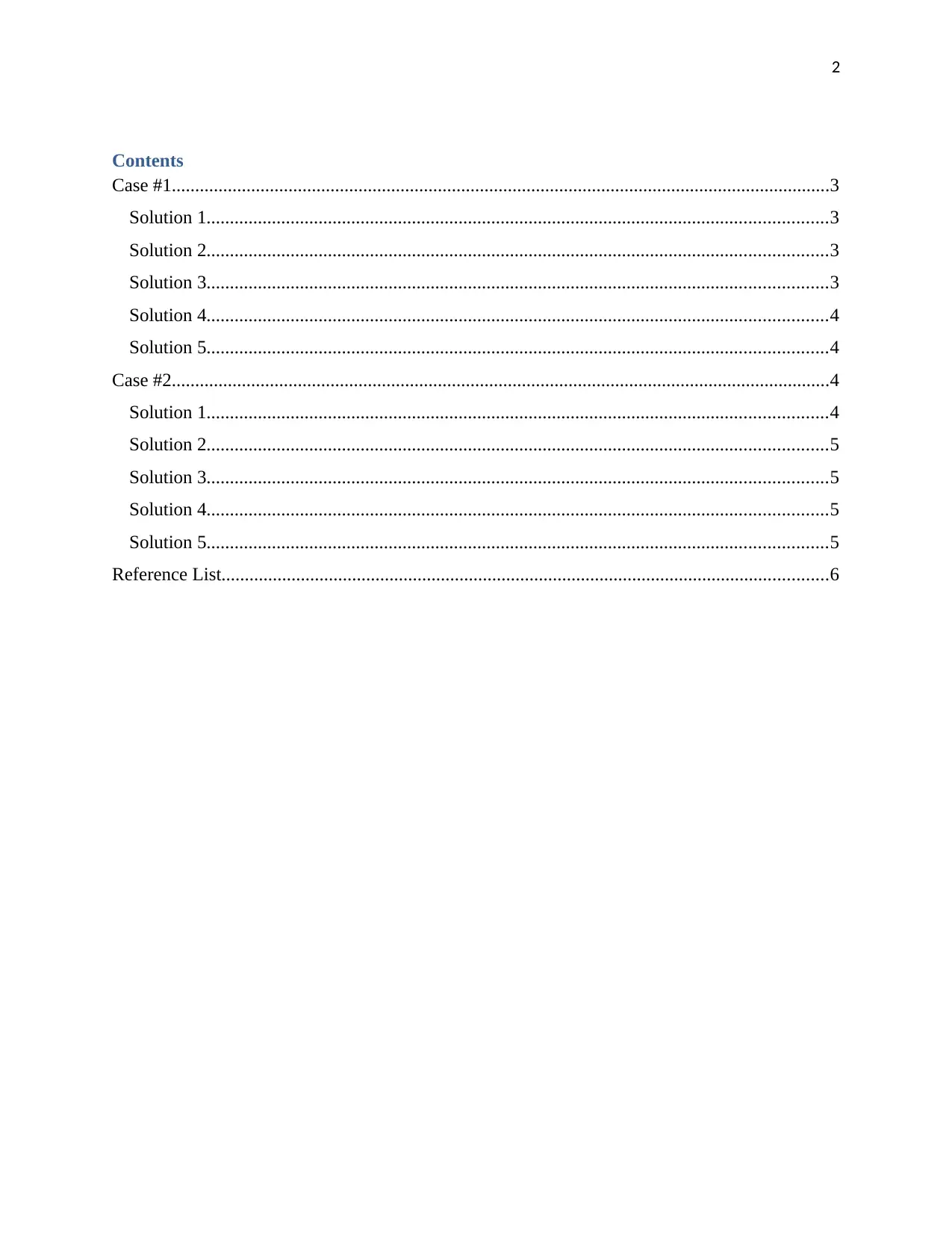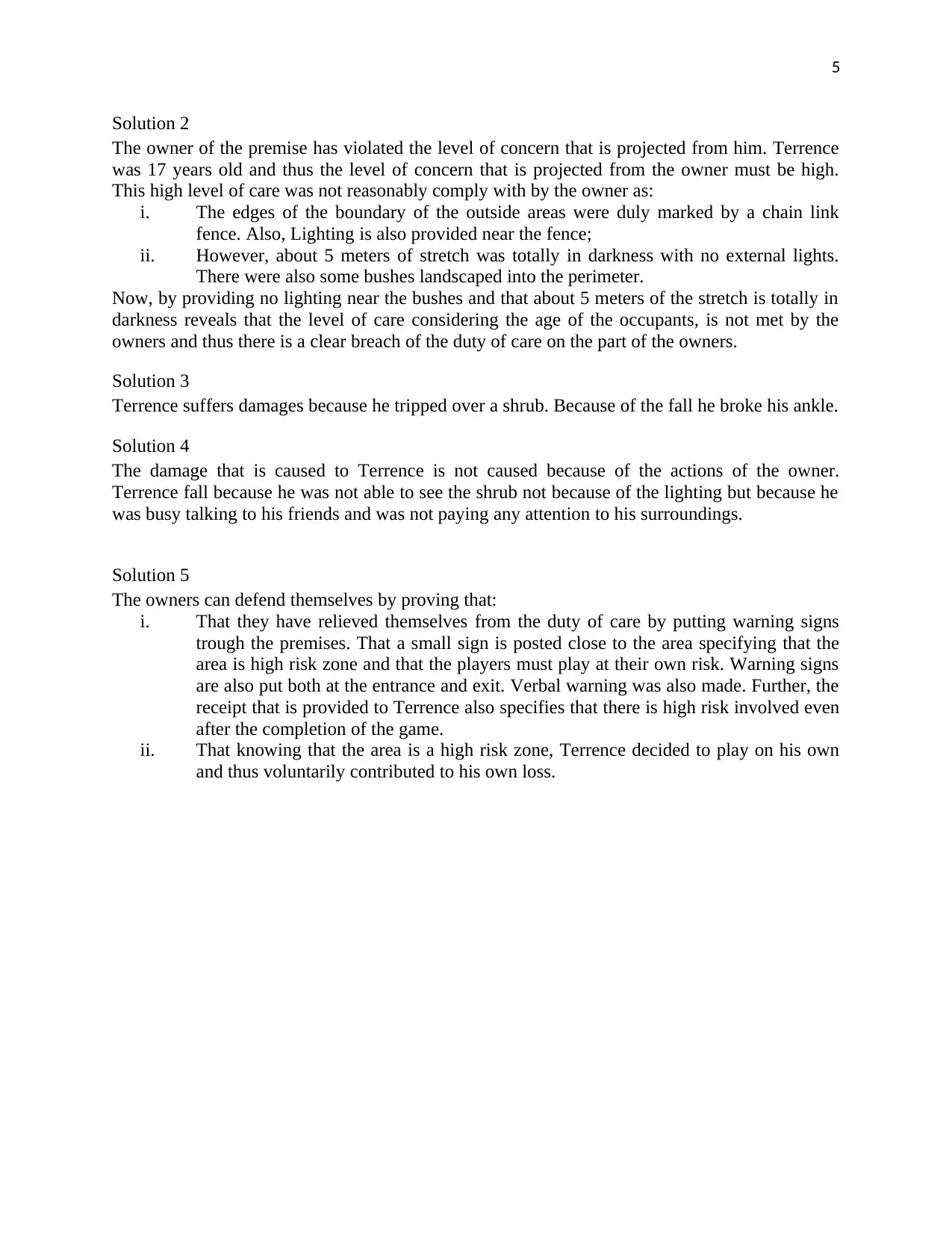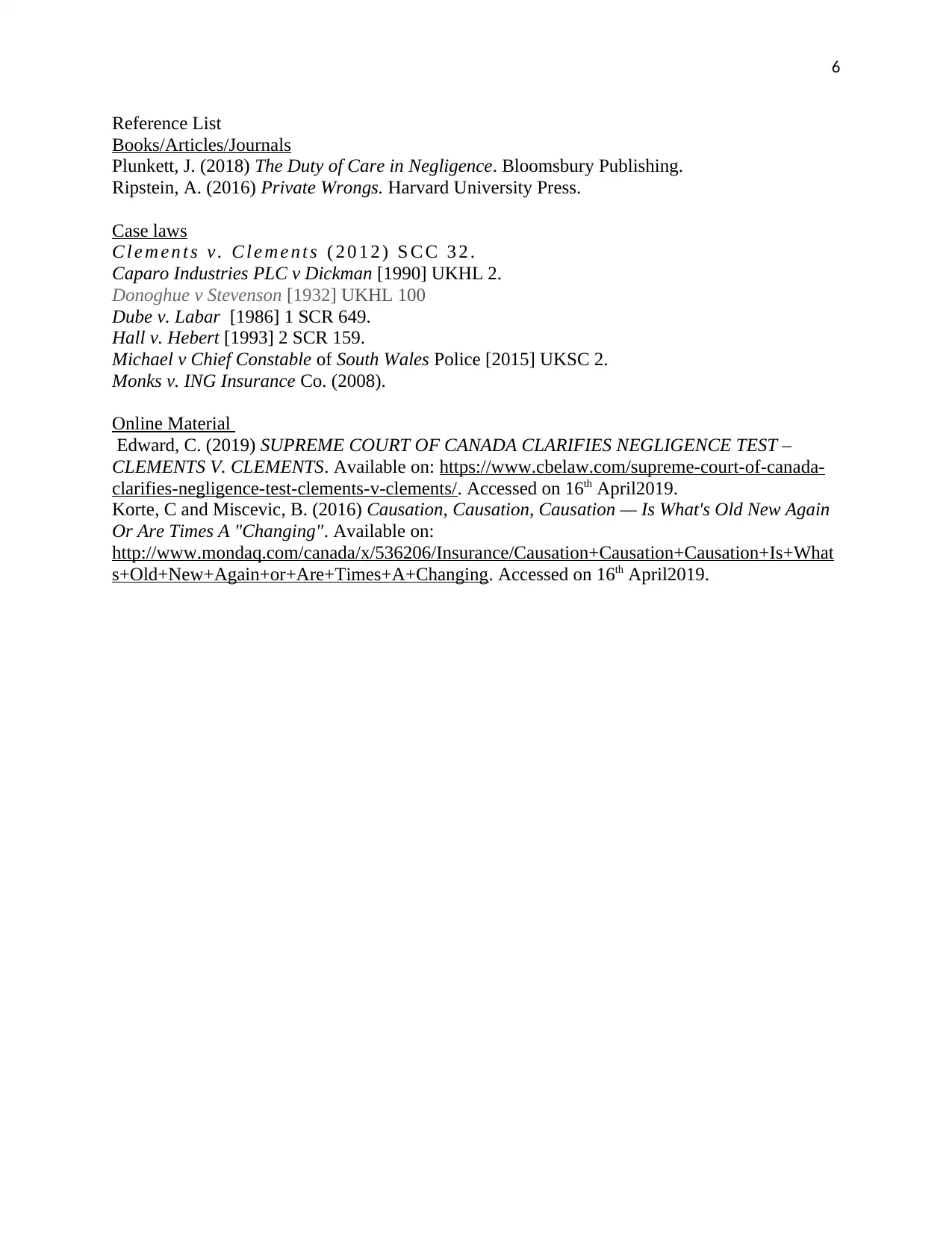Business Law Assignment: Case Study Analysis of Torts and Negligence
VerifiedAdded on 2023/01/19
|6
|1698
|74
Case Study
AI Summary
This document presents a detailed case study analysis of business law, specifically focusing on the law of torts and its impact on businesses. The assignment examines two distinct cases: the first involves a customer, Ab, who suffers injuries at a restaurant (Tremendous Treats) due to a wet floor, leading to a discussion of negligence, duty of care, breach of duty, and damages. The second case involves Terrence, who is injured at a paintball venue. The analysis explores the restaurant's and the venue owner's responsibilities, potential breaches of duty, and available defenses, such as volenti non fit injuria and contributory negligence. The assignment applies legal principles to the facts, providing a comprehensive understanding of tort law in a business context, including the concepts of proximity, reasonable foreseeability, causation, and remoteness. The solutions provided address legal arguments for both plaintiffs and defendants, referencing relevant case laws to support the conclusions.

1
Title Page
Name of the student
Student ID
Title Page
Name of the student
Student ID
Paraphrase This Document
Need a fresh take? Get an instant paraphrase of this document with our AI Paraphraser

2
Contents
Case #1.............................................................................................................................................3
Solution 1.....................................................................................................................................3
Solution 2.....................................................................................................................................3
Solution 3.....................................................................................................................................3
Solution 4.....................................................................................................................................4
Solution 5.....................................................................................................................................4
Case #2.............................................................................................................................................4
Solution 1.....................................................................................................................................4
Solution 2.....................................................................................................................................5
Solution 3.....................................................................................................................................5
Solution 4.....................................................................................................................................5
Solution 5.....................................................................................................................................5
Reference List..................................................................................................................................6
Contents
Case #1.............................................................................................................................................3
Solution 1.....................................................................................................................................3
Solution 2.....................................................................................................................................3
Solution 3.....................................................................................................................................3
Solution 4.....................................................................................................................................4
Solution 5.....................................................................................................................................4
Case #2.............................................................................................................................................4
Solution 1.....................................................................................................................................4
Solution 2.....................................................................................................................................5
Solution 3.....................................................................................................................................5
Solution 4.....................................................................................................................................5
Solution 5.....................................................................................................................................5
Reference List..................................................................................................................................6

3
Case #1
Solution 1
In negligence, Lord Atkin stated that each maker/defendant is duty bound to assure that no
wound is suffered to the plaintiff, provided; (Plunkett, 2018)
i. The plaintiff shares the connection of proximity with the defendant. Proximity
implies that defendant acts will impact plaintiff directly (Michael v Chief
Constable of South Wales Police [2015];
ii. That the defendant is only duty bound towards those plaintiffs who can be reasonably
foreseeable (Caparo Industries PLC v Dickman [1990].
TT is a chain of restaurant. A bowl soup is ordered by Ab and he chose to eat it in the restaurant.
He was told that the floor is washed and he must be careful. Ab asserted.
Now, AB can argue that TT owes him a duty of care as:
i. Neighborhood – TT is the restaurant and is duty bound to make sure that by no
acts/omission the customers face any kind of harm. The customers are the neighbor of
the restaurant as they are in proximate relationship. Any act/omission in the restaurant
will impact the customers directly.
ii. Reasonable foreseeability – The restaurant and the staff can reasonably anticipate the
presence of Ab in the restaurant as Ab decided to have the meal in the premises only..
Solution 2
In negligence, there should be breach of duty of care by defendant. The duty is violated when the
standard of concern that is probable from the defendant is not by him. The standard of care
implies the level and degree of care that is projected from the defendant. The degree is high
when the risk is high or when the gravity of harm is high or when the plaintiffs are children or
old people, etc and vice versa (C l e m e n t s v . C l e m e n t s ( 2 0 1 2 ) . (Edwards, 2019)
TT has breached the level of concern that is projected from it. Ab can argue that though the
server told him that the floor is wet, still there was no sign of warning, cautioning the people that
the floor is wet. The restaurant is filled with customers and is aware that since the wet areas are
not visible then it might result in causing injury to one of the customers. Thus, the standard of
concern that is projected is not met.
Solution 3
Damages imply that loss or the injury that is endured by the claimant because of the breach on
the part of the defendant. However, the defendant is accountable for only those damages which
are: (Korte and Miscevic, 2016)
i. Causation – incurred by acts of the wrongdoer (Monks v. ING Insurance Co. (2008)
ii. Remoteness – The defendant will compensate those damages which are reasonably
foreseeable.
Ab suffers damage because of the violation of the duty on the part of the restaurant. The potential
damage suffered by Ab includes:
i. He broke his hand and thus could not compete in the finals for the “Battle of the
Bands” competition. He missed the opportunity to get signed by music executives.
ii. Suffers burns from the spillage of the soup.
Ab has decided to sue TT for negligence, and claims TT owes him the amount of $10 million in
general and special damages, for the exorbitant salary he would have made in the music industry.
Case #1
Solution 1
In negligence, Lord Atkin stated that each maker/defendant is duty bound to assure that no
wound is suffered to the plaintiff, provided; (Plunkett, 2018)
i. The plaintiff shares the connection of proximity with the defendant. Proximity
implies that defendant acts will impact plaintiff directly (Michael v Chief
Constable of South Wales Police [2015];
ii. That the defendant is only duty bound towards those plaintiffs who can be reasonably
foreseeable (Caparo Industries PLC v Dickman [1990].
TT is a chain of restaurant. A bowl soup is ordered by Ab and he chose to eat it in the restaurant.
He was told that the floor is washed and he must be careful. Ab asserted.
Now, AB can argue that TT owes him a duty of care as:
i. Neighborhood – TT is the restaurant and is duty bound to make sure that by no
acts/omission the customers face any kind of harm. The customers are the neighbor of
the restaurant as they are in proximate relationship. Any act/omission in the restaurant
will impact the customers directly.
ii. Reasonable foreseeability – The restaurant and the staff can reasonably anticipate the
presence of Ab in the restaurant as Ab decided to have the meal in the premises only..
Solution 2
In negligence, there should be breach of duty of care by defendant. The duty is violated when the
standard of concern that is probable from the defendant is not by him. The standard of care
implies the level and degree of care that is projected from the defendant. The degree is high
when the risk is high or when the gravity of harm is high or when the plaintiffs are children or
old people, etc and vice versa (C l e m e n t s v . C l e m e n t s ( 2 0 1 2 ) . (Edwards, 2019)
TT has breached the level of concern that is projected from it. Ab can argue that though the
server told him that the floor is wet, still there was no sign of warning, cautioning the people that
the floor is wet. The restaurant is filled with customers and is aware that since the wet areas are
not visible then it might result in causing injury to one of the customers. Thus, the standard of
concern that is projected is not met.
Solution 3
Damages imply that loss or the injury that is endured by the claimant because of the breach on
the part of the defendant. However, the defendant is accountable for only those damages which
are: (Korte and Miscevic, 2016)
i. Causation – incurred by acts of the wrongdoer (Monks v. ING Insurance Co. (2008)
ii. Remoteness – The defendant will compensate those damages which are reasonably
foreseeable.
Ab suffers damage because of the violation of the duty on the part of the restaurant. The potential
damage suffered by Ab includes:
i. He broke his hand and thus could not compete in the finals for the “Battle of the
Bands” competition. He missed the opportunity to get signed by music executives.
ii. Suffers burns from the spillage of the soup.
Ab has decided to sue TT for negligence, and claims TT owes him the amount of $10 million in
general and special damages, for the exorbitant salary he would have made in the music industry.
⊘ This is a preview!⊘
Do you want full access?
Subscribe today to unlock all pages.

Trusted by 1+ million students worldwide

4
Solution 4
TT violated its duty and that resulted in Ab damages. That the damages that are caused are
because of the acts of TT as even though the server has told Ab that the floor is wet, still the wet
floor is not visible naturally. Also, there was no warning notice that was displayed by TT to
make the customers aware that the floor is wet. It is only because of the wet floor that the loss is
caused to Ab.
Solution 5
Generally, there are three potential defense upon which the defendant can rely: (Ripstein, 2016)
i. When the loss suffered by plaintiff is by his own conduct then it is the defense of
volenti non fit injuria (Dube v. Labar [1986].
ii. The injury to a agreived is incurred because of the contribution of both the defendant
and the plaintiff, then, it is the defense of contributory negligence (Hall v. Hebert
[1993];
iii. The defendant can also defend himself by submitting that he has bring the danger into
the notice of the plaintiff by putting warning notices.
Now, TT can rely on the defense of volenti non fit injuria by proving that the server had already
informed Ab regarding the floor bring wet but Ab still choose to walk on the floor at his own
free discretion knowing the danger involved.
Case #2
Solution 1
As per the facts, Terrence is a 19 years old boy along with his friends went to play at the local
venue (Paintball Extreme). The play area was both outside and inside the building. Now, the
owners of the venue do owe Terrence a duty of care because:
i. Terrence and his friends were present in the play area and it is the duty of the
occupier of the premises to assure that no damage be caused to inviters/trespassers. In
Donoghue v Stevenson [1932] a duty of care is imposed on the premises occupiers
towards that people who are found to be in the vicinity of the premises including the
trespassers. They are considered to be in proximate relationship and thus neighbors;
ii. Also, the premises occupier is aware that there are chances that people or children
might come to the play area and thus they are reasonably foreseeable.
So, there exists duty of care upon the owner of the venue towards Terrence.
Solution 4
TT violated its duty and that resulted in Ab damages. That the damages that are caused are
because of the acts of TT as even though the server has told Ab that the floor is wet, still the wet
floor is not visible naturally. Also, there was no warning notice that was displayed by TT to
make the customers aware that the floor is wet. It is only because of the wet floor that the loss is
caused to Ab.
Solution 5
Generally, there are three potential defense upon which the defendant can rely: (Ripstein, 2016)
i. When the loss suffered by plaintiff is by his own conduct then it is the defense of
volenti non fit injuria (Dube v. Labar [1986].
ii. The injury to a agreived is incurred because of the contribution of both the defendant
and the plaintiff, then, it is the defense of contributory negligence (Hall v. Hebert
[1993];
iii. The defendant can also defend himself by submitting that he has bring the danger into
the notice of the plaintiff by putting warning notices.
Now, TT can rely on the defense of volenti non fit injuria by proving that the server had already
informed Ab regarding the floor bring wet but Ab still choose to walk on the floor at his own
free discretion knowing the danger involved.
Case #2
Solution 1
As per the facts, Terrence is a 19 years old boy along with his friends went to play at the local
venue (Paintball Extreme). The play area was both outside and inside the building. Now, the
owners of the venue do owe Terrence a duty of care because:
i. Terrence and his friends were present in the play area and it is the duty of the
occupier of the premises to assure that no damage be caused to inviters/trespassers. In
Donoghue v Stevenson [1932] a duty of care is imposed on the premises occupiers
towards that people who are found to be in the vicinity of the premises including the
trespassers. They are considered to be in proximate relationship and thus neighbors;
ii. Also, the premises occupier is aware that there are chances that people or children
might come to the play area and thus they are reasonably foreseeable.
So, there exists duty of care upon the owner of the venue towards Terrence.
Paraphrase This Document
Need a fresh take? Get an instant paraphrase of this document with our AI Paraphraser

5
Solution 2
The owner of the premise has violated the level of concern that is projected from him. Terrence
was 17 years old and thus the level of concern that is projected from the owner must be high.
This high level of care was not reasonably comply with by the owner as:
i. The edges of the boundary of the outside areas were duly marked by a chain link
fence. Also, Lighting is also provided near the fence;
ii. However, about 5 meters of stretch was totally in darkness with no external lights.
There were also some bushes landscaped into the perimeter.
Now, by providing no lighting near the bushes and that about 5 meters of the stretch is totally in
darkness reveals that the level of care considering the age of the occupants, is not met by the
owners and thus there is a clear breach of the duty of care on the part of the owners.
Solution 3
Terrence suffers damages because he tripped over a shrub. Because of the fall he broke his ankle.
Solution 4
The damage that is caused to Terrence is not caused because of the actions of the owner.
Terrence fall because he was not able to see the shrub not because of the lighting but because he
was busy talking to his friends and was not paying any attention to his surroundings.
Solution 5
The owners can defend themselves by proving that:
i. That they have relieved themselves from the duty of care by putting warning signs
trough the premises. That a small sign is posted close to the area specifying that the
area is high risk zone and that the players must play at their own risk. Warning signs
are also put both at the entrance and exit. Verbal warning was also made. Further, the
receipt that is provided to Terrence also specifies that there is high risk involved even
after the completion of the game.
ii. That knowing that the area is a high risk zone, Terrence decided to play on his own
and thus voluntarily contributed to his own loss.
Solution 2
The owner of the premise has violated the level of concern that is projected from him. Terrence
was 17 years old and thus the level of concern that is projected from the owner must be high.
This high level of care was not reasonably comply with by the owner as:
i. The edges of the boundary of the outside areas were duly marked by a chain link
fence. Also, Lighting is also provided near the fence;
ii. However, about 5 meters of stretch was totally in darkness with no external lights.
There were also some bushes landscaped into the perimeter.
Now, by providing no lighting near the bushes and that about 5 meters of the stretch is totally in
darkness reveals that the level of care considering the age of the occupants, is not met by the
owners and thus there is a clear breach of the duty of care on the part of the owners.
Solution 3
Terrence suffers damages because he tripped over a shrub. Because of the fall he broke his ankle.
Solution 4
The damage that is caused to Terrence is not caused because of the actions of the owner.
Terrence fall because he was not able to see the shrub not because of the lighting but because he
was busy talking to his friends and was not paying any attention to his surroundings.
Solution 5
The owners can defend themselves by proving that:
i. That they have relieved themselves from the duty of care by putting warning signs
trough the premises. That a small sign is posted close to the area specifying that the
area is high risk zone and that the players must play at their own risk. Warning signs
are also put both at the entrance and exit. Verbal warning was also made. Further, the
receipt that is provided to Terrence also specifies that there is high risk involved even
after the completion of the game.
ii. That knowing that the area is a high risk zone, Terrence decided to play on his own
and thus voluntarily contributed to his own loss.

6
Reference List
Books/Articles/Journals
Plunkett, J. (2018) The Duty of Care in Negligence. Bloomsbury Publishing.
Ripstein, A. (2016) Private Wrongs. Harvard University Press.
Case laws
C l e m e n t s v . C l e m e n t s ( 2 0 1 2 ) S C C 3 2 .
Caparo Industries PLC v Dickman [1990] UKHL 2.
Donoghue v Stevenson [1932] UKHL 100
Dube v. Labar [1986] 1 SCR 649.
Hall v. Hebert [1993] 2 SCR 159.
Michael v Chief Constable of South Wales Police [2015] UKSC 2.
Monks v. ING Insurance Co. (2008).
Online Material
Edward, C. (2019) SUPREME COURT OF CANADA CLARIFIES NEGLIGENCE TEST –
CLEMENTS V. CLEMENTS. Available on: https://www.cbelaw.com/supreme-court-of-canada-
clarifies-negligence-test-clements-v-clements/. Accessed on 16th April2019.
Korte, C and Miscevic, B. (2016) Causation, Causation, Causation — Is What's Old New Again
Or Are Times A "Changing". Available on:
http://www.mondaq.com/canada/x/536206/Insurance/Causation+Causation+Causation+Is+What
s+Old+New+Again+or+Are+Times+A+Changing. Accessed on 16th April2019.
Reference List
Books/Articles/Journals
Plunkett, J. (2018) The Duty of Care in Negligence. Bloomsbury Publishing.
Ripstein, A. (2016) Private Wrongs. Harvard University Press.
Case laws
C l e m e n t s v . C l e m e n t s ( 2 0 1 2 ) S C C 3 2 .
Caparo Industries PLC v Dickman [1990] UKHL 2.
Donoghue v Stevenson [1932] UKHL 100
Dube v. Labar [1986] 1 SCR 649.
Hall v. Hebert [1993] 2 SCR 159.
Michael v Chief Constable of South Wales Police [2015] UKSC 2.
Monks v. ING Insurance Co. (2008).
Online Material
Edward, C. (2019) SUPREME COURT OF CANADA CLARIFIES NEGLIGENCE TEST –
CLEMENTS V. CLEMENTS. Available on: https://www.cbelaw.com/supreme-court-of-canada-
clarifies-negligence-test-clements-v-clements/. Accessed on 16th April2019.
Korte, C and Miscevic, B. (2016) Causation, Causation, Causation — Is What's Old New Again
Or Are Times A "Changing". Available on:
http://www.mondaq.com/canada/x/536206/Insurance/Causation+Causation+Causation+Is+What
s+Old+New+Again+or+Are+Times+A+Changing. Accessed on 16th April2019.
⊘ This is a preview!⊘
Do you want full access?
Subscribe today to unlock all pages.

Trusted by 1+ million students worldwide
1 out of 6
Related Documents
Your All-in-One AI-Powered Toolkit for Academic Success.
+13062052269
info@desklib.com
Available 24*7 on WhatsApp / Email
![[object Object]](/_next/static/media/star-bottom.7253800d.svg)
Unlock your academic potential
Copyright © 2020–2025 A2Z Services. All Rights Reserved. Developed and managed by ZUCOL.





